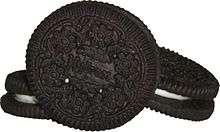Hydrox

Hydrox is the brand name for a creme-filled chocolate sandwich cookie manufactured by Leaf Brands. It debuted in 1908, and was manufactured by Sunshine Biscuits for over 90 years.[1] The similar Oreo cookie, introduced in 1912, was inspired by the Hydrox. The Oreo eventually exceeded in popularity which resulted in the Hydrox being perceived as an imitator, although it was the original.[2] Hydrox was largely discontinued in 1999 after Sunshine was acquired by Keebler, which was later acquired by Kellogg's. In September 2015, the product was re-introduced by Leaf Brands. Compared to Oreos, Hydrox cookies have a less-sweet filling and a crunchier cookie shell that has been noted to become less soggy in milk.[3]
Name
In 1908, the creators of the cookie sought a name that would convey "purity and goodness" and derived their choice from the component elements that comprise the molecule of water (Hydrogen and Oxygen).
Production
Sunshine Biscuits was purchased by Keebler in 1996, and in 1999, Keebler replaced Hydrox with a similar but reformulated product called Droxies.[2] Keebler was acquired by Kellogg's in 2001. Kellogg's removed Droxies from the market in 2003.[1] Kellogg's marketed a similar chocolate sandwich cookie under the Famous Amos brand, along with sandwich cookies of other flavors, but has discontinued the line.[3]
On the cookie's 100th anniversary, Kellogg's resumed distribution of Hydrox under the Sunshine label, with the first batches shipped in late August 2008. Hydrox aficionados had bombarded Kellogg's with thousands of phone calls and an on-line petition asking that production resume. The recipe was slightly altered from the original; trans-fats were removed.[4] The cookies were to be available nationally for a limited time, and less than a year later Kellogg's had removed Hydrox from their web site.
The Carvel ice-cream franchise sold ice-cream goods manufactured with "Hydrox" cookie crumbs until 2012. Carvel used the cookies' all-kosher status as a selling point as the original Oreo recipe used lard.[3] The cookies were not specifically mentioned by name on the Carvel website, but they were identified as hydrox (lower-case 'h') on the in-store posters. Carvel currently uses Oreo cookies in its ice cream goods.
Re-introduction by Leaf Brands
In 2014, Leaf Brands registered the Hydrox trademark which had been abandoned by former owner Kellogg's.[5] Leaf began production of their version of Hydrox on September 4, 2015 at the company’s facility in Vernon, California.[6] In 2017 the recipe was changed to remove artificial flavors that had been used for 50 years[7] and the company obtained non-GMO certification[8].
Leaf Brands filed a Federal Trade Commission complaint in 2018 against Mondelez, maker of Oreo cookies, for hiding Hydrox cookies from customers on store shelves.[9][10][11]
See also
References
- 1 2 Eber, H. (February 26, 2012). "The Big O: The Chelsea-born Oreo cookie celebrates its 100th birthday". New York Post. pp. 44–45.
- 1 2 Paul Lukas (15 March 1999). "Oreos to Hydrox: Resistance Is Futile". Fortune. Retrieved 2009-11-29.
- 1 2 3 Christopher Rhoads (19 January 2008). "The Hydrox Cookie Is Dead, and Fans Won't Get Over It". The Wall Street Journal. Retrieved 2009-11-29.
- ↑ Christopher Rhoads (28 May 2008). "Hydrox Redux: Cookie Duels Oreo, Again". The Wall Street Journal. Retrieved 2009-11-29.
- ↑ Kestenbaum, David (23 September 2015). "One Man's Mission To Bring Back Hydrox Cookies". NPR.org. Retrieved 2016-10-04.
- ↑ Schroeder, Eric (4 September 2015). "Leaf Brands begins production of Hydrox cookies". Food Business News. Retrieved 20 September 2015.
Leaf Brands L.L.C. officially relaunched Hydrox cookies on Sept. 4 with the onset of production at the company’s facility in Vernon, Calif.
- ↑
- ↑
- ↑ "Hydrox-Oreo Rivalry Heats Up with FTC Complaint". foodandwine.com. Retrieved 6 September 2018.
- ↑ "Hydrox Cookies". www.facebook.com. Retrieved 6 September 2018.
- ↑ "Cookie-hiding claim fuels Oreo-Hydrox flareup". foodbusinessnews.net. Retrieved 6 September 2018.